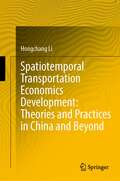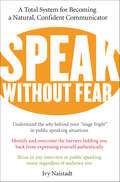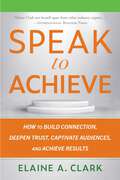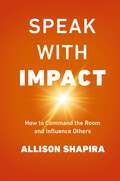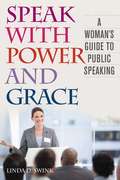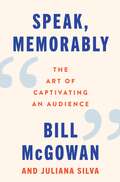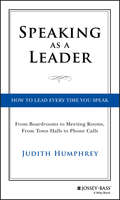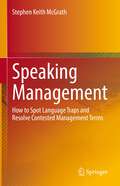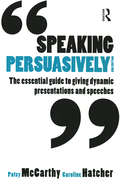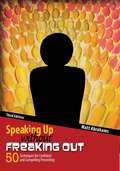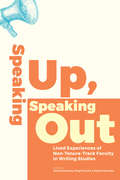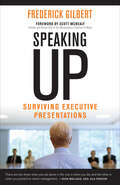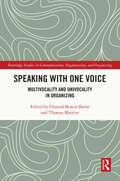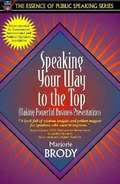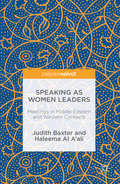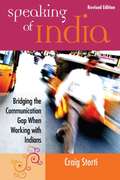- Table View
- List View
Spatiotemporal Transportation Economics Development: Theories and Practices in China and Beyond
by Hongchang LiThis book focuses on the analysis of transportation economics development with spatiotemporal characteristics in both theory and practice. The comprehensive and general theory development, practical transportation events and policy implications are addressed. The book pursues three main objectives: firstly, to structurally describe the overall spatiotemporal transportation theory development; secondly, to break down transportation elements and transportation modes into railway, highway, water, civil aviation, pipeline and urban transportation for the purposes of in-depth professional analysis; and thirdly, to summarize transportation trends including car-hailing, shared bicycles, etc., in China to reveal their policy implications.
Speak Strong: Say What You Mean! Mean What You Say. Don't Be Mean When You Say It
by Meryl Runion“Speak Strong!” It’s a leadership skill, a success strategy and a moral imperative. Research shows 90% of us stay silent in situations that call for strong words. Don’t want to rock the boat? Author Meryl Runion, CSP, explains why some boats NEED to be rocked…for the right reasons…at the right time…in the right way. Know when it’s time to speak up, overcome resistance to unwelcome truths, establish and implement boundaries, create new communication standards, supercharge your message, elevate the quality of your conversations, overcome destructive communication habits, put your best foot forward sincerely. One hour audio CD included containing the entire searchable PDF of the bestselling PowerPhrases! book so you can immediately get the words to apply your SpeakStrong skills. The CD also includes a communication style inventory, the flash presentation of "The Legend of Mighty Mouth and of A World of Truth" and more. Meryl Runion’s "PowerPhrases!" book Series has helped over a quarter million readers find the perfect phrases to communicate clearly. “Speak Strong” is the perfect “next step” for those who rely on communication skills to build successful careers and relationships.
Speak Up!: A Woman's Guide to Presenting Like a Pro
by Cyndi Maxey Kevin E. O'ConnorThe insider's guide for women who want to master the art of business, professional, and public speakingWhether speaking one-on-one or one to one thousand, women have specific challenges that can get in the way of their ability to convey ideas and engage an audience. Public speaking professionals Cyndi Maxey and Kevin O'Connor give women the tips and tools they need to be able to speak clearly, with confidence and conviction, and present information effectively.In SPEAK UP!, you'll learn how to:Deal with difficult colleaguesSpeak on the spotUse technology in support of your messageSell your ideas with passion and power Connect confidently with your superiorsFor any woman who wants to get her point across, from the boss' office, to the conference room, to a convention center, SPEAK UP! will help you polish your presentation skills, get heard, and get what you want.
Speak Without Fear: A Total System for Becoming a Natural, Confident Communicator
by Ivy NaistadtFor many of us, public speaking is at best a chore marked by great anxiety and at worst a potential career stopper. Ours is a time when the ability to communicate in front of individuals or groups in all types of business and other situations is becoming paramount. Speak Without Fear offers a unique, practical process for combating the stage fright that plagues us every day in these situations. Unlike other books on public speaking, Speak Without Fear goes beyond the external techniques, such as how to breathe properly and keep eye contact, to delve deeply into the reason for your performance anxiety. It gets to the root of what's giving you the sweats so you can identify what's in the way and work through it to communicate naturally and comfortably before audiences of any size. Ivy Naistadt's easy-to-follow, step-by-step program will help you: Identify the degree and type of your nervousness Pinpoint the incidents and issues that, directly or indirectly, cause you fear and loathing in the spotlightDevelop and master a technique for over-coming your anxiety that's adaptable to your level of experience and needUse your new skills to shine in a variety of situations -- whether speech making, interviewing, auditioning, or presenting No matter how anxious you are about going before an audience -- any audience, whether it's 1 or 1,000 -- Speak Without Fear will give you the tools to speak powerfully and persuasively.
Speak Your Way To Cash®: How To Start At The Top Of The Speaking Market Instead Of Working Your Way Up From The Bottom!
by Ashley KirkwoodTruth bomb: Making excellent money as a paid speaker is not about how well-known you are. Instead, it’s about how you package your speech and present yourself. In Speak Your Way to Cash, entrepreneur and professional speaking coach Ashley N. Kirkwood takes you behind the scenes and unlocks the secrets to landing high-paying five- and six-figure corporate speaking contracts using her firm’s proprietary P.A.I.D. Method. Ashley developed her method while taking herself from someone who spoke for free at the Rotary Club to being an in-demand corporate speaker commanding five to six figures. And she did this in record time.
Speak from the Heart
by Theresa Foy Digeronimo Steve AdubatoIn Speak from the Heart, Emmy Award-winning broadcaster, newspaper columnist, and motivational speaker Steve Adubato reveals the secrets to being a great communicator -- with a program that will dramatically change the way you talk, listen, and connect with others. Steve Adubato's life experiences, both professional and as a husband, son, brother, and father, have taught him invaluable lessons about the power of personal, sincere communication. In Speak from the Heart, he demonstrates that being a truly great communicator is not simply about being articulate or being a "good talker." It is not about fancy visuals and PowerPoint presentations, or hard-core sales pitches, or even who has the most facts, figures, and technical wizardry. What really counts is making an authentic connection with other people that comes not merely from the intellect but from the heart. If you want to make a lasting impact, Dr. Adubato shows you how to engage people through empathy and understanding, how to be a great listener, and how to make an audience -- whether one, one hundred, or one thousand people -- care about you and your message. He helps you to rely less on written speeches, teleprompters, and index cards full of too much forgettable information, and learn, instead, how to tell a compelling story and create excitement and enthusiasm. You will learn, for example, how to: Lecture less and engage more Communicate under pressure Make effective use of eye contact Develop a conversational style Inspire in a human, personal way Become comfortable with your core message Speak from the Heart will not only make it easier for you to communicate your message without being ignored or misunderstood; it will also improve your relationships with other people and help you to become more productive at work -- with more satisfaction and less stress. Written by a man who has trained thousands of professionals in all walks of life, including corporate managers, lawyers, educators, health professionals, salespeople, and customer service reps, Speak from the Heart is for anyone who interacts with others at work, at home, in the community, or at social functions.
Speak to Achieve: How to Build Connection, Deepen Trust, Captivate Audiences, and Achieve Results
by Elaine A. ClarkLearn Necessary Skills to Become a Better Communicator and Achieve Genuine and Impactful Connections Many people struggle with public speaking or conveying their desired message directly and genuinely, even though such skills are essential to success in many spaces. In Speak to Achieve, author Elaine A. Clark shares her forty years of earned wisdom as an actor and voice-over coach on how to improve your communication style to achieve your individual goals, whether addressing an audience of one or one thousand, in person, in a podcast, on a livestream, or in a short-form video. Clark&’s proven Making It M.I.N.E.® performance method coaches aspiring speakers to get out of their heads; access their emotions; connect with their personal truth; incorporate authoritative body movements; comfortably share their history, uniqueness, and personality; and sustain listener attention. With Speak to Achieve, become a better communicator using the following steps:Acknowledge and overcome roadblocks.Build trust between yourself and your audience.Construct a genuine bridge of connection.Use your personal journey to empower others.Captivate audiences.Motivate the audience to think, feel, and take action!This interactive guide gives readers small assignments to acknowledge, test, and apply Clark's techniques. With Speak to Achieve, learn to own your inherent authority and intelligence, feel empowered by your message, and communicate genuinely with others to achieve your desired results.
Speak to Win: How to Present with Power in Any Situation
by Brian TracyThe ability to speak with confidence and deliver winning presentations can accelerate your career, earn people's respect, and enable you to achieve your greatest goals.Anyone can learn to be a great speaker, just as easily as they can learn to drive a car or ride a bike. As one of the world's premier speakers and personal success experts, Brian Tracy reveals time-tested tricks of the trade that you can use to present powerfully and speak persuasively, whether in an informal meeting or in front of a large audience.In Speak To Win, you will learn how to:become confident, positive, and relaxed in front of any audiencegrab people's attention from the startuse body language, props, and vocal techniques to keep listeners engagedtransition smoothly from one point to the nextuse humor, stories, quotes, and questions skillfullydeal with skepticism when presenting new ideaswrap up strongly and persuasivelyThis no nonsense handbook is perfect for delivering talks that inform, impress, persuade and motivate.Brimming with unbeatable strategies for winning people over every time, Speak To Win lets you in on his most powerful presentation secrets in this indispensable, life-changing guide.
Speak with Confidence: Overcome Self-Doubt, Communicate Clearly, and Inspire Your Audience
by Mike AckerBuild your communication confidence and master the ability to inspire your audience In Speak with Confidence: Overcome Self-Doubt, Communicate Clearly, and Inspire Your Audience, keynote speaker, author, and executive communication coach Mike Acker delivers a practical and hands-on playbook to building the confidence you need to nail your next presentation, speech, virtual talk, or social media post. In this proven pathway to becoming a capable and confident speaker, you’ll discover how to combine your identity, message, and skills into one persuasive package. The author explains how to uncover your identity, define your message, and develop your skills and techniques to become a master communicator. From overcoming imposter syndrome to eliminating a victim mentality, you’ll explore concrete methods for improving your presence and ability to take command of a room. You’ll also find: The elements of a confident message, including a personal investment in the topic you’re discussing Strategies for overcoming limiting beliefs that hold you back and artificially reduce your ability to lead Ways to understand your audience and learn to hone in on the place where your purpose intersects with your audience’s needsAn essential new strategy guide for anyone seeking to improve their ability to speak to a group, Speak with Confidence is the public speaking blueprint you’ve been waiting for.
Speak with Impact: How to Command the Room and Influence Others
by Allison ShapiraYour voice matters, especially as a leader.Every day, you have an opportunity to use your voice to have a positive impact--at work or in your community. You can inspire and persuade your audience--or you can distract and put them to sleep.Nervous, rambling robotic--these presentation styles can ruin a talk on even the most critical topics. And with each weak performance, career prospects dim.To get ahead and make an impact, you need to deliver well-crafted messages with confidence and authenticity. You must sound as capable as you are.Public speaking is a skill, not a talent. With the right guidance, anyone can be a powerful speaker. Learn to conquer fear, capture attention, motivate action, and take charge of your career with Speak with Impact. Written by an opera singer turned CEO, speaker, and executive communication coach, the book unravels the mysteries of commanding attention in any setting, professional or personal.Whether it’s speaking up at a meeting, presenting to clients, or talking to large groups, the book’s easy-to-use frameworks, examples, and exercises help youKickstart the creative processCompose a clear and concise messageEngage your audience through storytelling and humorBanish filler words and uptalkStrengthen and project your voiceUse breathing techniques to overcome stage frightUse effective body languageBuild your executive presenceDeliver presentations with confidence and authenticityWhen you know what to say and how to say it, people listen. Find your powerful voice… and step into leadership. Speak with impact.
Speak with Power and Grace: A Woman's Guide to Public Speaking
by Richard L. Weaver II Linda D. SwinkDrawing on her own successful experience and presenting advice from top female executives, Linda D. Swink guides women through each step of preparing for a speech and how to deliver it by using visual aids, voice control, and humor, among other techniques. Information is provided for both novice and expert speakers, so every woman will learn something new. This valuable guide will empower any woman who wants her words to be taken seriously and reach new levels of success.
Speak, Memorably: The Art of Captivating an Audience
by Bill McGowan Juliana SilvaThe media guru and bestselling author of Pitch Perfect helps professionals break away from canned communications and find their true—and most effective—voice no matter the workplace. The business world has adopted the wrong definition of successful communication. For many years, being “on message” was considered the prime directive. The overwhelming majority of professionals today exist in a rigidly narrow range of bland rhetoric, throwing around industry buzzwords and empty jargon to create the impression of business savvy. But when everyone sounds messaged (and the same), no one stands out. And now, with more ways than ever to get your message across, it’s never been harder to communicate clearly and have your message stick.Bill McGowan has devoted more than twenty years to helping people find their distinctive voice. From CEOs to White House staffers to television personalities, he has coached thousands of speakers to make their narrative more memorable and distinctive by breaking free from the challenges preventing them from selling their ideas with conviction, motivating their teams during challenging times, or clearly articulating a company’s mission.Speak, Memorably offers concrete strategies and tools to help anyone, in any stage of their career, cut through the numbing sameness of cliches and boring business rhetoric and find their authentic voice. Inspiring and entertaining, it is a masterclass in interpersonal communication and an inspiring call to action for professionals to break free from forgettable “brand” speak and instead craft thoughtful and memorable messages.
Speaking As a Leader
by Judith HumphreyMake every communication count--with a simple, four-step speaking modelWhether it's among colleagues at lunch or an audience of a thousand, a leader's role is to move and inspire others. It's not only the big occasions that test a leader's mettle, but the little ones as well--in a casual conversation in the elevator, in phone calls, or one of many incidental, seemingly "insignificant" interactions in everyday work life. Written by one of the world's leading communications coaches, Speaking as a Leader shows you how to make the most of your daily communications, creating a presence on the job as a genuine and constant leader.In this eye-opening guide, aspiring (and established) leaders can enhance their reputations and influence by following a few simple steps. Speaking as a Leader:Shows how to structure your thoughts and message in any situation using a four-step modelOffers tips on listening effectively, in three dimensionsDetails why you are the best visual and how to avoid "Death by PowerPoint"Offers guidance on taking the "numb" out of numbersIncludes tips on moving from subject to messageWith Speaking as a Leader, you'll learn to tap into your innate leadership skills at every occasion--whether small or large--and earn the sort of respect that creates devoted friends and passionate supporters.
Speaking Being: Werner Erhard, Martin Heidegger, and a New Possibility of Being Human
by Bruce Hyde Drew KoppSpeaking Being: Werner Erhard, Martin Heidegger, and a New Possibility of Being Human is an unprecedented study of the ideas and methods developed by the thinker Werner Erhard. In this book, those ideas and methods are revealed by presenting in full an innovative program he developed in the 1980s called The Forum—available in this book as a transcript of an actual course led by Erhard in San Francisco in December of 1989. Since its inception, Erhard’s work has impacted the lives of millions of people throughout the world. Central to this study is a comparative analysis of Erhard’s rhetorical project, The Forum, and the philosophical project of Martin Heidegger. Through this comparative analysis, the authors demonstrate how each thinker’s work sometimes parallels and often illuminates the other. The dialogue at work in The Forum functions to generate a language which speaks being. That is, The Forum is an instance of what the authors call ontological rhetoric: a technology of communicating what cannot be said in language. Nevertheless, what does get said allows those participating in the dialogue to discover previously unseen aspects of what it currently means to be human. As a primary outcome of such discovery, access to creating a new possibility of what it is to be human is made available. The purpose of this book is to show how communication of the unspoken realm of language—speaking being—is actually accomplished in The Forum, and to demonstrate how Erhard did it in 1989. Through placing Erhard’s language use next to Heidegger’s thinking—presented in a series of “Sidebars” and “Intervals” alongside The Forum transcript—the authors have made two contributions. They have illuminated the work of two thinkers, who independently developed similar forms of ontological rhetoric while working from very different times and places. Hyde and Kopp have also for the first time made Erhard’s extraordinary form of ontological rhetoric available for a wide range of audiences, from scholars at work within a variety of academic disciplines to anyone interested in exploring the possibility of being for human beings. From the Afterword: I regard Speaking Being as an enormously important contribution to understanding Heidegger and Erhard. The latter has received far too little serious academic attention, and this book begins to make up for that lack. Moreover, the book’s analysis of Heidegger’s thought is among the best that I have ever read. I commend this book to all readers without reservation. Michael E. Zimmerman, Professor Emeritus, University of Colorado, Boulder
Speaking Management: How to Spot Language Traps and Resolve Contested Management Terms
by Stephen Keith McGrathThis book identifies ten linguistic traps in our everyday language usage and provides philosophical justification for a method of determining internally consistent definitions of groups of related terms that avoid all ten traps. Various examples and applications of this method are given throughout. The book demonstrates how the seemingly straightforward matter of our understandings of the meaning of words can have major implications for the exercise of power. This book illustrates how this insight originated from management research into project governance that found lack of agreement on the definition of that term, as well as on many other important management terms. To resolve this, the impacts of evolution, philosophy and linguistics upon our everyday language usage were investigated. The research documented in this book found that the human tool called language works well for describing physical objects but has difficulty producing a common understanding of the meaning of concepts - a problem not restricted to the management field. That field is simply a microcosm that exposes a much more widespread linguistic usage problem affecting our personal, religious and political lives; one that existed at the time of Plato and Aristotle and has laid hidden for millennia. This book includes a lexicon of 69 commonly used but confused or contested management terms, all developed by applying its definitional method. The terms include governance, power, ethics, leadership and their associated groups of terms. The book explores how disagreement can be resolved using these new clear definitions and extends this into an analysis of who ‘good’ ethics are good for. It also incorporates a section on “how to speak management and actually know what you are talking about”, written in the style of an ‘idiots guide’ or ‘guide for dummies’. This identifies common, everyday circumstances in which lack of agreed definitions cause avoidable confusion and provides the book’s focus on conflict dissolution rather than on conflict resolution.
Speaking Persuasively: The essential guide to giving dynamic presentations and speeches
by Caroline Hatcher Patsy McCarthyTo succeed in business, your message must be heard, understood and remembered. This book, with its combination of practical tips and case studies from the experts, will help you to become a more powerful and persuasive speaker, whether pitching for business or presenting to the Board. As a consultant in speech training, I can recommend it unreservedly.Clare Willis, Senior Consultant, Speak First Training, LondonYOU CAN BECOME A CONFIDENT PUBLIC SPEAKERSpeaking is one of the most powerful ways of influencing others at work and in life. And yet for many of us, speaking in front of large or small groups of people is one of our greatest fears. Speaking Persuasively shows you how to convert anxiety into effective communication. LEARN HOW TO GIVE DYNAMIC PRESENTATIONS AND SPEECHESUsing real examples, Speaking Persuasively shows you how to hone your speaking skills in business and politics, in the classroom and in the community. It explains how to order your material, attract the audience's attention (and keep it), control your voice and adapt your techniques for different situations. It also includes practical advice on making a successful business pitch, communicating across cultures and handling the media.Speaking Persuasively is for anyone who wants to become a more persuasive and more impressive public speaker. Valuable information that will make the first-timer more comfortable and the gifted public speaker more persuasive. Shari Armistead, Senior Media Advisor to Queensland Minister for EducationStrips away the mystery of the mass media performance. A useful guide for those on both sides of the microphone.Ellen Fanning, television and radio presenter
Speaking Up without Freaking Out: 50 Techniques for Confident and Compelling Presenting,
by Matt Abrahams50 Scientifically-Supported Techniques to Create More Confident and Compelling Speakers.
Speaking Up, Speaking Out: Lived Experiences of Non-Tenure-Track Faculty in Writing Studies
by Jessica Edwards Meg McGuire Rachel SanchezSpeaking Up, Speaking Out addresses the lived experiences of those working in the non-tenure-track faculty (NTTF) trenches through storytelling and reflection. By connecting NTTF voices from various aspects of writing studies, the collection offers fresh perspectives and meaningful contributions, imagining the possibilities for contingent faculty to be valued and honored in educational systems that often do the opposite. Challenging traditional ways of seeing NTTF, the work contains multiple entry points to NTT life: those with and without “terminal degrees,” those with PhDs, and those who have held or currently hold tenured positions. Each chapter suggests tangible ways that writing departments and supporters can be more thoughtful about their policies and practices as they work to create more equitable spaces for NTTF. Speaking Up, Speaking Out considers the rhetorical power of labeling and asserts why contingent faculty, for far too long, have been compared to and against TT faculty and often encouraged to reach the same or similar productivity with scholarship, teaching, and service that TT faculty produce. The myopic ideas about what is valued and whose position is deemed more important impacts contingent faculty in ways that, as contributors in this collection share, effect and affect faculty productivity, emotional health, and overall community involvement. Contributors: Norah Ashe-McNalley, Sarah Austin, Rachel Azima, Megan Boeshart Burelle, Peter Brooks, Denise Comer, Jessica Cory, Liz Gumm, Brendan Hawkins, Heather Jordan, Nathalie Joseph, Julie Karaus, Christopher Lee, John McHone, Angie McKinnon Carter, Dauvan Mulally, Seth Myers, Liliana M. Naydan, Linda Shelton, Erica Stone, Elizabeth Vincelette, Lacey Wootten
Speaking Up: Surviving Executive Presentations
by Frederick GilbertIf you are in middle management, to get anything done you must present your ideas to decision makers, and those presentations can be brutal. The stakes are high—one presentation can make or break a career—but the rules are utterly unclear. Tactics and techniques that work well with peers, subordinates, and immediate supervisors can actually work against you when presenting up the chain. Speaking Up is an indispensable resource for anyone who needs to know how to present to those at the highest levels. Psychologist and coach Frederick Gilbert offers revelatory insights into the minds of the men and women at the top—information that is crucial to understanding what they're looking for from presenters. Based on ten years of research and hundreds of interviews, Speaking Up features extensive comments from executives explaining exactly what they want and don't want in a presentation and includes nine chapters containing QR codes for free videos on the chapter topics. This is a must-read book for surviving high-stakes meetings.
Speaking With One Voice: Multivocality and Univocality in Organizing (Routledge Studies in Communication, Organization, and Organizing)
by Chantal Benoit-Barné Thomas MartineThis book explores the dynamics and challenges that underlie the ability of organizations to speak with one voice. Contributions by experienced and emerging scholars shed light on the nature and regulation of the communication processes whereby the many and diverse voices of a collective can unite, act, and speak as a distinct entity, thus contributing to its organizing. By focusing on communicational events, whether in the context of for-profit and non-profit organizations, political protests or social movements, chapters guide the reader through the diverse manifestations and concrete ways of dealing with the imperative for organizations of all kinds to speak with one voice. In doing so, the book creates bridges between different perspectives with regard to the notion of voice and its significance for the study of organizing; between fields of study; and between theory and empirical research aimed at investigating organizing beyond the boundaries of the formal organization. Offering a thorough and comprehensive investigation of the dynamics between multivocality and univocality in the organizing of various collectives, this book will be an important resource for scholars and students of organizational communication, management studies, media studies and rhetorical studies.
Speaking Your Way to the Top: Making Powerful Business Presentations
by William D. Thompson Marjorie Brody"Who needs another book on public speaking, let alone a series of them? After all, this is a skill best learned by practice and "just doing it," you say. True, but insight from people who've already been where you are might help ease some bumps along the road and provide handy advice on handling stage fright and knotty speech assignments. After all, if practice is the best solution to public speaking excellence, why is this country so full of speakers who can't speak effectively? Consider politicians, business executives, sales professionals, teachers, and clerics who often fail to reach their audience because they make elementary mistakes, such as speaking too fast or too long, failing to prepare adequately, and forgetting to analyze their audiences."
Speaking as Women Leaders
by Judith Baxter Haleema A’aliThis book offers new insights on how senior business women in Middle Eastern and Western companies use language for effective leadership in their respective management meetings. The book explores six case studies of women leaders, three in UK companies and three in a Bahraini company. The authors analyse meeting and transcript data to show that, in both cultural contexts, the women negotiate a range of gendered discourses such as 'hierarchy and status' and 'masculinisation' in order to manage their teams with authority and skill. The book challenges received wisdom about the opportunities and constraints each cultural context offers women in public life. While the UK women are constrained by chronic change and uncertainty in performing their roles effectively, the Bahraini women are far better supported by their bosses, yet are constrained by patriarchal assumptions of what constitutes effective leadership. The book demonstrates the use of Feminist Poststructuralist Discourse Analysis (FPDA), which is applied by scholars worldwide yet has relatively few published models of practice.
Speaking of Economics: How to Get in the Conversation (Economics As Social Theory Ser.)
by Arjo KlamerMaking sense of economists and their world in a persuasive and entertaining style, Arjo Klamer, the author of a number of influential books including Conversation with Economists and The Consequences of Economic Rhetoric, shows that economics is as much about how people interact as it is about the models, the mathematics, the econometrics, the theo
Speaking of India
by Craig StortiWith more than a dozen years of experience working between India and the Western world, author Craig Storti understands how misunderstanding, misinterpretation, and missed deadlines can impede business success. Teaching readers how to bridge the cultural divide, Storti offers a set of best practices that will enable Westerners and Indians to work together with extraordinary results.
Speaking of India: Bridging The Communication Gap When Working With Indians
by Craig StortiWesterners and Indians are working more closely together and in greater numbers than ever before. The opportunities are vast, but so is the cultural divide. Misunderstandings and frustration due to cultural differences wreak havoc on success. In this revised edition of Speaking of India, author and intercultural communications expert Craig Storti attempts to ease the frustration, and bring cultural understanding in business and life. With a new foreword by Ranjini Manian, author of Doing Business in India for Dummies, the book also features new content on managing remotely, and the results of a five-year cultural survey. With more than a dozen years of experience working between the two cultures, Storti has identified key cultural flashpoints and the result is a powerful series of Best Practices, which is the basis of Speaking of India.
